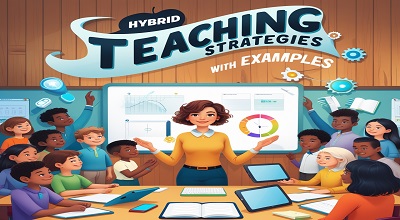Hybrid Teaching Strategies
Hybrid Teaching Strategies: Hybrid teaching has emerged as a transformative approach in education, blending traditional in-person instruction with online learning to create flexible, inclusive, and engaging learning environments. This model caters to diverse learning preferences and needs, making education more accessible and adaptable. In this comprehensive guide, we will explore the latest hybrid teaching strategies, provide practical examples, and address common questions to help educators implement effective hybrid learning experiences.
Understanding Hybrid Teaching
Hybrid teaching, also known as blended learning, integrates face-to-face classroom methods with online activities. This approach allows students to benefit from direct interaction with instructors and peers while also engaging in self-paced online learning. The goal is to combine the strengths of both modalities to enhance student engagement, learning outcomes, and accessibility.
Key Hybrid Teaching Models
Traditional Hybrid Model
Structure: A portion of the course is delivered in-person, while the remainder is conducted online.
Example: A university course where students attend lectures on campus twice a week and complete assignments and discussions online.
Flipped Classroom
Structure: Students review instructional content at home and engage in interactive activities during class time.
Example: Students watch pre-recorded lectures at home and participate in group discussions or problem-solving sessions during class.
Concurrent Hybrid (HyFlex)
Structure: Students have the option to attend classes in-person, online synchronously, or asynchronously.
Example: A course where students can choose to attend lectures live, watch recorded sessions later, or participate in online discussions.
Effective Hybrid Teaching Strategies
Clear Communication of Expectations
Importance: Ensures all students understand course requirements, deadlines, and participation expectations.
Implementation: Provide detailed syllabi, regular announcements, and accessible course materials.
Utilization of Technology Tools
Importance: Enhances interaction, collaboration, and access to resources.
Implementation: Use platforms like Zoom for live sessions, Google Classroom for assignments, and Padlet for collaborative activities.
Active Learning Techniques
Importance: Promotes student engagement and deeper understanding.
Implementation: Incorporate activities like group projects, peer reviews, and interactive quizzes.
Flexible Assessment Methods
Importance: Accommodates diverse learning styles and paces.
Implementation: Offer a mix of formative assessments, such as quizzes and discussions, and summative assessments like projects and exams.
Building a Learning Community
Importance: Fosters a sense of belonging and support among students.
Implementation: Create opportunities for students to interact through discussion forums, group activities, and virtual office hours.
Free Download: Fightback APK
Examples of Hybrid Teaching in Practice
- Elementary Education: Teachers use digital manipulatives and instructional videos to enhance learning experiences for both in-person and remote students.
- Higher Education: Universities implement HyFlex models, allowing students to choose their preferred mode of attendance, thereby increasing accessibility and engagement.
- Corporate Training: Organisations adopt blended learning approaches, combining online modules with in-person workshops to provide flexible professional development opportunities.
Challenges in Hybrid Teaching
Technological Barriers
Issue: Not all students have access to reliable internet or devices.
Solution: Provide resources like loaner devices or offline materials to ensure equitable access.
Engagement Across Modalities
Issue: Maintaining student engagement in both in-person and online settings can be challenging.
Solution: Use interactive tools and varied instructional methods to keep students engaged.
Assessment Integrity
Issue: Ensuring fair and accurate assessments in a hybrid environment.
Solution: Implement diverse assessment strategies and use plagiarism detection tools.
Future Trends in Hybrid Teaching
Integration of Artificial Intelligence
Impact: AI can provide personalised learning experiences and automate administrative tasks.
Expansion of Virtual Reality (VR) and Augmented Reality (AR)
Impact: VR and AR can create immersive learning environments, enhancing student engagement and understanding.
Increased Focus on Lifelong Learning
Impact: Hybrid models support continuous education, allowing learners to acquire new skills throughout their lives.
FAQs
What is hybrid teaching?
Answer: Hybrid teaching combines in-person and online learning experiences to provide flexible and inclusive education.
How can I implement hybrid teaching effectively?
Answer: Utilize clear communication, appropriate technology tools, active learning strategies, flexible assessments, and foster a supportive learning community.
What are the benefits of hybrid teaching?
Answer: Hybrid teaching offers flexibility, accommodates diverse learning styles, increases accessibility, and promotes student engagement.
What challenges might I face in hybrid teaching?
Answer: Challenges include technological barriers, maintaining engagement across modalities, and ensuring assessment integrity.
What is the future of hybrid teaching?
Answer: The future includes the integration of AI, VR/AR technologies, and a greater emphasis on lifelong learning.
Conclusion
Hybrid teaching represents a dynamic and adaptable approach to education, catering to the diverse needs of learners.
